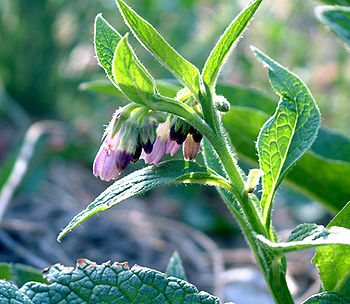Comfrey
Other Names : Ass Ear, Black Root, Blackwort, Bruisewort, Common Comfrey, Consolidae Radix, Consound, Consoude, Consoude Officinale, Consuelda, Grande Consoude, Gum Plant, Healing Herb, Herbe aux Charpentiers, Herbe à la Coupure, Knitback, Knitbone, Langue-de-Vache, Oreille d’Âne, Salsify, Slippery Root, Symphytum officinale, Wallwort.
Special Precautions of Comfrey
- Comfrey is UNSAFE for anyone when taken by mouth. It contains chemicals (pyrrolizidine alkaloids, PAs), that can cause liver damage, lung damage, and cancer. The FDA has recommended removal of oral comfrey products from the market.
- Comfrey seems to be safe for most people when applied to unbroken skin in small amounts for less than 10 days. It’s important to remember that the poisonous chemicals in comfrey can pass through the skin. Absorption of the chemicals increases if the skin is broken or if large amounts are applied.
- Pregnancy and breast-feeding: Comfrey is LIKELY UNSAFE to take by mouth or apply to the skin if you are pregnant or breast-feeding. In addition to causing liver damage and possibly cancer, the PAs in comfrey might also cause birth defects. Even topical use is unwise, since the PAs can be absorbed through the skin.
- Broken or damaged skin: Don’t apply comfrey to broken or damaged skin. Doing so might exposure you to large amounts of the chemicals in comfrey that can cause liver damage and other serious health effects.
- Liver disease: There is a concern that comfrey might make liver disease worse. Don’t use comfrey if you have any problems with your liver.
The benefits of Comfrey are
Comfrey is a perennial shrub that is native to Europe, and its roots and leaves are sold as ointments, compounds oils, creams, compresses and leaf extracts for a variety of medicinal purposes. Comfrey has been found to be TOXIC to the liver when taken internally, and may cause hepatoxicity. As such, oral use of comfrey has been banned in North America and the UK and comfrey is currently only sold for TOPICAL purposes. Yet we now know that taking comfrey internally can damage the liver. While old-timers still use the roots in external applications, modern complementary and herbal medicine practitioners recommend using the leaves only. If you’re making your own comfrey salve, UMMC strongly recommends using only older leaves. The younger leaves and roots contain higher amounts of the dangerous pyrrolizidine alkaloids, which can be absorbed through skin. Many herbalists still prefer the roots to the leaves because the roots contribute more skin-soothing mucilage. But roots may also hold as much as 16 times the level of the alkaloids, warns UMMC.
- Comfrey contains minerals, vitamins and numerous phytochemicals, which are potent antioxidant compounds found in plants. The leaves and roots contain the phytochemicals allantoin and tannins, which both help new skin cells to form and they thereby promote wound healing and healthy skin. Comfrey leaves and roots also contain rosmarinic acid, which is a phytochemical that helps to reduce inflammation.
- Comfrey is used topically to reduce the inflammation of, and promote the healing of, strains, fractures, pulled muscles and broken bones, states the University of Maryland Medical Center, or UMMC. It is also used to reduce the pain and inflammation associated with osteoarthritis. According to Phyllis Balch in her book "Prescription for Nutritional Healing," comfrey helps to speed the healing of various skin conditions including skin rashes, sunburns, dermatitis and psoriasis. Comfrey is also used for the treatment of bedsores, bites and stings, bruises, inflamed bunions, burns, dry skin, leg ulcers, nosebleeds and scabies.
- Back Pain : The benefits of topical applications of comfrey are based primarily on anecdotal evidence, and little research has been done to confirm the efficacy of comfrey for its purported uses. A study was done however by the "British Journal of Sports Medicine" regarding the use of comfrey for the treatment of back pain. The study, which was published in the July 2010 issue, concluded that there was a significant difference between the comfrey extract and placebo group regarding pain intensity. In fact, the comfrey extract caused a 95.2 percent decrease in perceived pain during standard movements and it produced the pain-relieving effects rapidly.
